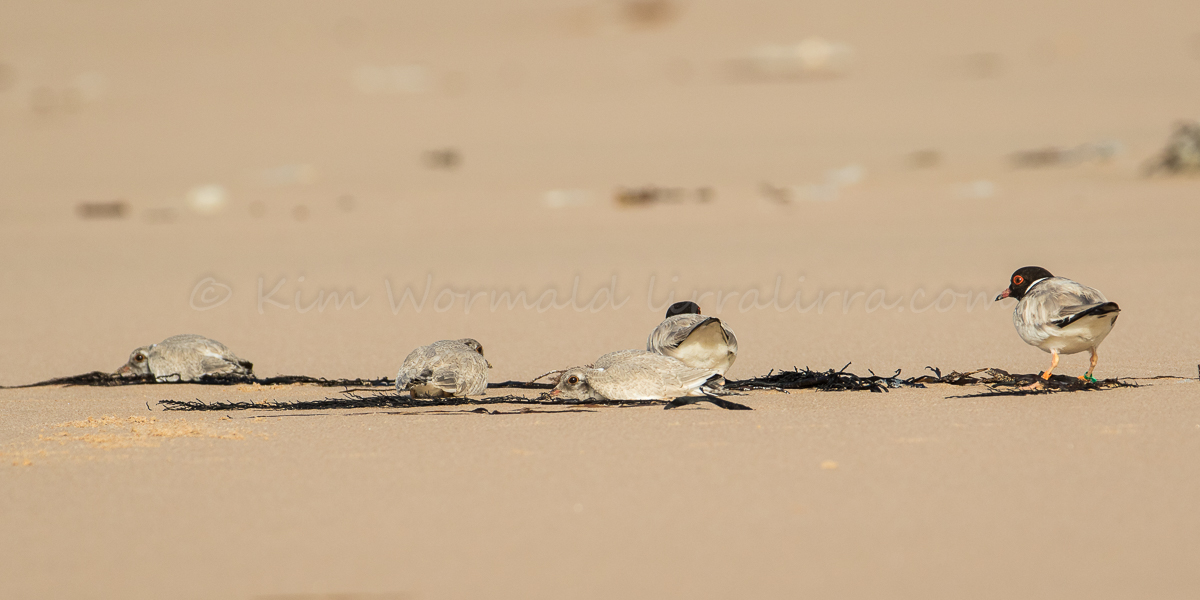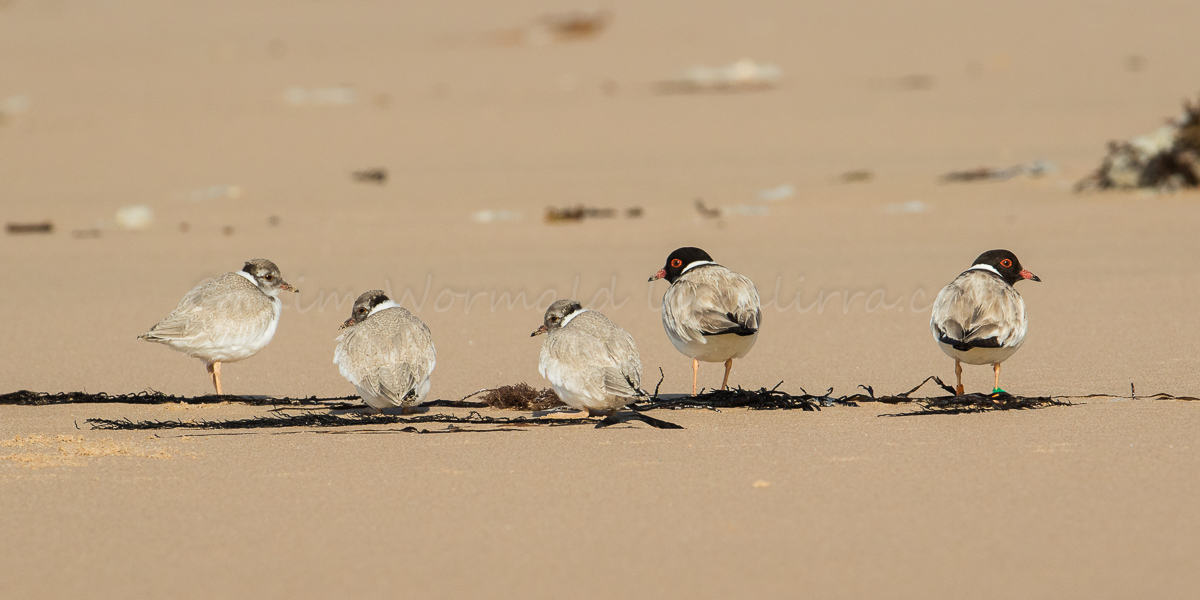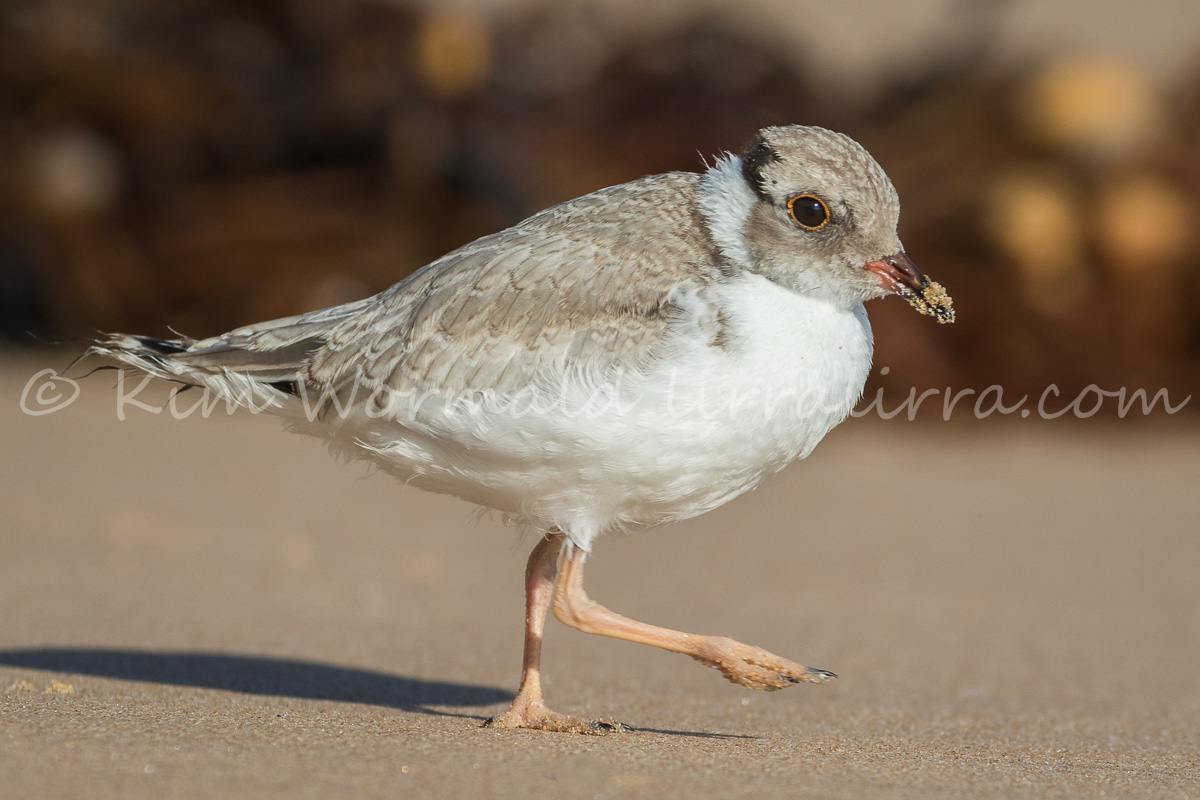Hooded Plovers (Thinornis rubricollis rubricollis – Eastern) are threatened on Phillip Island. They are small beach-nesting shorebirds that face grave dangers when trying to raise their chicks. I was totally blessed to see this little family at Surfies Point recently.
 Hooded Plover family (Thinornis rubricollis rubricollis) – stashed
Hooded Plover family (Thinornis rubricollis rubricollis) – stashed
I spent many hours watching this family as they approached the critical fledging time. Hooded Plover chicks fend for themselves from day one but they are unable to fly to safety until they reach five weeks. The only defense they have against potential predators is to ‘stash’ or go to ground. When I’m watching hoodies I can tell, to a certain extent, what is happening behind me by their behaviour. When they stashed the chicks this time it was because someone was walking along the beach with an on-lead dog at the edge of the water, about 50m away. They stayed stashed for several minutes. If multiple visits are made to their territory the chicks can be stashed for long sections of the day which can be disastrous if the weather is very hot or cold. It also causes problems by reducing their foraging time which in turn affects their health and growth-rate.
 Hooded Plover family (Thinornis rubricollis rubricollis) – stashed
Hooded Plover family (Thinornis rubricollis rubricollis) – stashed
I like the way they stashed themselves on sprigs of seaweed to enhance the camouflage of their own disruptive colouring. Even from a few metres away they are incredibly difficult to see. When the hoodie parents feel that the danger has receded they slowly stand and the chicks follow suit.
It was super lucky that this stash occurred on the focal plane of my camera as none of the birds were in the background and therefore out of focus. The background and foreground blur is what makes the birds stand out in these images, without the selective focus their browns, whites and blacks would be lost among the browns, whites and blacks of the beach itself.
 Hooded Plover (Thinornis rubricollis rubricollis) – chick
Hooded Plover (Thinornis rubricollis rubricollis) – chick
When I photograph birds I tend to stash myself (I’ve never thought of it that way before, how funny!) and hope that the birds will evenutally feel comfortable enough to come towards me. When the three little chicks in this family started running towards me I held my breath and went into a zone where I pulled together everything I’ve learned about bird photography. The image above is one of the series I took while being feasted on by March flies. I love the detail I was able to capture, especially the twirly feathers at the end of its tail, the grains of sand on its bill, the dark feathers emerging on its head, the softness of its tummy feathers, the detail of its tiny nails and the twinkle in its eye.
Please excuse the more obtrusive watermarks but I’m extra-specially fond of these images. I am, however, happy for them to be used on request for conservation purposes. The second image has already been used at a recent Dogs’ Breakfast to help island beach users learn more about the vulnerable hoodies.
On Phillip Island this nesting season 43 nests were started (several were 2nd, 3rd and even a 4th attempt to raise chicks). Hooded Plovers usually lay 3 eggs per nest, which would have resulted in about 129 eggs. Instead only 70 eggs were laid, but most of those eggs were lost and only 23 chicks hatched. Of those 23 chicks just 12 survived. As grim as those figures sound this was a good year for hoodies on the island, as good or better than during the previous 23 years – many thanks to the rangers, volunteers and mindful beach users.
Happy birding, Kim
~ Thank you for your visit and comments.
~ If you’d like to receive a weekly email informing you that lirralirra has been updated please join the growing list of subscribers and add your email address to the ‘subscribe’ box above right.

Wonderful pictures. I saw one of these guys when I was visiting Australia in January but there were a long ways off. It is great to see one up close and their young too. thanks for sharing the pictures.
You were so lucky to see them while on a holiday Thomas! You must either be a very dedicated birder or a very lucky one. I’m glad you enjoyed the images.
Wow I’m so thankful that there are people committed to preserving this gorgeous species. They are such darling little critters! I love your dedication to get these amazing shots.
When I read the first part of your post I thought it’s like the pot calling the kettle white I’m glad you like the images and I agree about the wonderful people out there.
I’m glad you like the images and I agree about the wonderful people out there.
Wow that is such a high mortality rate – it makes me sad. I love these images more than I can say!
Aw thank you for caring Sherry. I think hoodies are in a similar situation to your Piping Plovers, but if my research was right a while ago your beaches are closed while they raise their chicks. That would be so good.
It was so lovely to go hoodie hunting with you! It was lovely to sit on the beach and watch those beautiful birds!
It was wonderful! I wish I’d taken a photograph of the crazy tracks we made
Beautiful photos, Kim. Are you using your new 7DII camera and your new 100-400mm lens.
I loved reading your running commentary…I was caught up in the moment.
March flies are nasty creatures aren’t they….I love your dedication to your bird photography.
Carole.
I agree, March flies are hideous! I’m still not 100% happy with the 7DII but am triple-checking it’s not me before sending it back for checking. I’ve got one more lot of testing to do. The lens is lovely.
Love to everyone who help these sweet little birds, including you!
And you’re one them too because of your responsible dog ownership, so thank you!
12 survivors is a good year!!!
If ever anything brought home to me (again) how fragile their grasp is, that statement did it.
I am so sorry. And so grateful for the efforts of people to keep their fragile perfection going. Our world is diminished each time we lose a species. Any species.
Thank you for an incredible photo.
That’s so interesting EC, you’ve put it in perspective perfectly. I agree about species loss, Australia has a very poor record when it comes to losing species